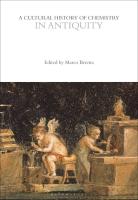
Bloomsbury (2023) h/b 312pp £75 (ISBN 9781474294539)
This superb book is the first volume in the series ‘A Cultural History of Chemistry’. The succeeding volumes cover the Middle Ages, the Early Modern Age, the Eighteenth Century, the Nineteenth Century and the Modern Age with the full six-volume set costing £395. This volume is, in fact, three books in one. Each chapter explores a theme that is then further divided into three regional parts. Egypt is covered by Sydney H. Aufrère (CNRS, France), Mesopotamia by Cale Johnson (Freie Universität Berlin) and the Greco-Roman World by Matteo Martelli (University of Bologna). The themes of the chapters are then thoughtfully summarised by editor Marco Beretta (Professor of the History of Science at the University of Bologna). The Greco-Roman World is of particular interest here at Classics for All, but the knowledge gained in Egypt and Mesopotamia was, patchily in parts, handed down to both Greece and Rome for their continuing use.
The individual contributors to the chapters have their own, different, styles. All four are highly engaging and the content is always interesting but the interfaces between them are not always smooth. No matter, it is always an engrossing read and B.’s chapter summaries perform an excellent job in tying the sections together.
In the Introduction, the origin of the word chemistry is discussed without any firm conclusions being reached. Did it stem from the Egyptian kemet (a black pigment), the Greek kymeia (indicating fusion) or the Akkadian kamû (to bake or roast)? We may never know for certain. The writings of the Greco-Egyptian alchemist Zosimos of Panopolis, at the end of the 3rd C AD, introduced chymeia in a wider discussion of the practices that could produce colour changes in metals. This is certainly chemistry as we would recognise it.
The first chapter deals with Theory and Concepts. This is an obvious place to start, but the point is made that it would be far too simplistic to say that chemistry was directly descended from alchemy. As B. points out, the science we now call chemistry simply did not exist until much later. Neither was alchemy an organised science. However, there was a clear shift along the timeline towards systematising the semi-random empirical facts that were gleaned along the way into something resembling methodical knowledge and procedures. Chapter 2 (Practice and Experiment) and Chapter 3 (Laboratories and Technology) might easily have been combined as the stories they tell are inextricably linked. The production of lead oxide (lithargê) in various allotropes from various argentiferous lead ores is woven into a complex story of medicines and pigments. This blossoms into a more detailed discussion about metal corrosion (to produce rust, verdigris etc.) and the use of various mineral combinations to purify gold.
Chapter 4 (Culture and Science) covers the interface between proto-chemistry and the gods, myths and religions of the times. Gods were often portrayed as fabulous craftsmen in Greco-Roman mythology and generous benefactors who passed on their technical skills to humankind. However, these gifts from the gods included several lead compounds which, in truth, must have caused a great deal of harm. Vitruvius noted that water carried in earthen pipes tastes better than water that has passed through the lead pipes that were widely used throughout Rome’s impressive aqueduct system. His advice, it seems, went unheeded.
Chapter 5 (Society and Environment) explores the impact that the chemistry of the times had on the ancient environment and landscape. As we know, especially today, industrial chemistry leaves scars. Mining and quarrying leave obvious scars and these were unchecked and uncontrolled. Only when the materials being mined ran out did the work stop. There is a telling picture of an ice core from Greenland showing the extent of the atmospheric pollution. Human remains in western Jordan contain clearly hazardous levels of lead and thallium poisoning. We were also faced with extensive deforestation to support the ancient chemical industries. Clearly, then as now, there were pros and cons to having these activities.
Leading directly from this, Chapter 6 (Trade and Industry) tells the story of the societies that grew up because of the ancient chemical industry. However, the distinction between workshops and shops (both referred to as ergastēria) was not clear-cut in ancient sources, and it remains difficult to reconstruct the steps through which products reached markets. That said, the number of products circulating around the Egyptian, Mesopotamian and Greco-Roman worlds is quite staggering.
But how was all this knowledge passed on? Chapter 7 (Learning and Institutions) looks at the institutions tasked with creating the next generation of chemists. The art of making recipe books originated in Egypt and Mesopotamia and transferred then to Greece and Rome. The Greco-Roman artisans were organised in guilds and operated within specialised and standardised sets of rules. Recipes recorded in hieroglyphic inscriptions ended up in recipe books elsewhere and provide an enduring testimony to the circulation of knowledge.
Finally, Chapter 8 (Art and Representation) takes a painstaking look at the art and iconography surrounding ancient chemistry. Hephaestus (Vulcan in the Roman world) was the god of metal-working and he is often depicted at work. Likewise, artwork showing bronze workshops, smelting, fullers, smiths and other trades are numerous. B. includes some excellent examples in this section.
There is an excellent index, and a comprehensive bibliography with fifty pages of references. The text is augmented by numerous grey-scale illustrations which are always apposite to the discussion.
An Open Access edition of this book is available for download (at http://doi.org/10.5040/9781474203746) under a Creative Commons BY-NC-ND 4.0 licence on www.bloomsburycollections.com.
John Timney
